In recent years we have detected a growing problem of low employee engagement in many companies, regardless of sector, size or ownership structure.
According to Gallup, the consulting company with most experience in the subject, only 13% of employees around the world are clearly engaged (http://ow.ly/Ti64I), as reflected in the tables below.
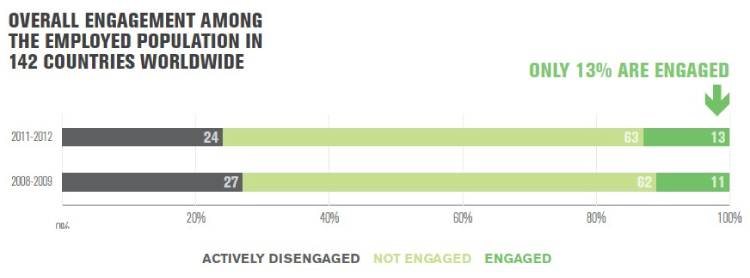
In Spain, although our engagement level is as much as 18%, we are facing with alarming indicators showing that 60% of thefts concerning consumer goods are perpetrated by employees, amounting to over 1,000 million euros/year (http://ow.ly/Ti6x5).

Such indicators should not be generalized, but there is great concern as to how we should focus on this management challenge and transform it into a competitive advantage, and this is one of the most important objectives of CEOs and HR executives. It is a challenge that calls for a dual approach:
a) To identify the specific elements of engagement (positive and negative) according to the strategy and culture of each organization.
b) To deploy both short and medium term people management initiatives on the basis of detected issues and increasingly involve employees from different areas and hierarchical levels in their design.
And this should all be implemented in a VUCA (Volatility, Uncertainty, Complexity and Ambiguity) environment that has come to stay. What must we do then? How can we define an employee engagement strategy and how can we transform it into a differential characteristic of our company?
1. What is the definition of employee engagement?
Although engagement is generally confused with motivation or satisfaction, it is quite a different concept with a greater impact on organizational success and should therefore be well clarified.
Motivation is defined as a set of stimuli motivating people to perform certain actions and to be persistent in their achievement. Such achievement drivers are multifactorial and are made up of components such as enthusiasm, energy, effort, self-responsibility, result-targeting, resilience and tenacity.
Satisfaction involves a sense of self-realization related to the fulfilment of expectations or needs, but does not necessarily entail implication in the medium or long term, so there may be satisfied employees with a high risk of voluntary rotation.
Engagement is the work bond at a rational, emotional and transcendent level, seeking the mutual benefit of employees and companies through their proactive attitude in maintaining the quality of this bond in the long term.
This gives rise to three sets of conduct beneficial to the success of the company and the happiness of employees:
– Employees’ making additional effort (what Anglo-Saxons call the “extra mile”)
– A strong willingness to be a long-term company employee: low risk of voluntary rotation due to a profound loyalty to the organization, in both good times and bad times.
– Openness to and support for the necessary transformation of the organization so as to stay competitive, even when this might entail making personal sacrifices.
Thus, we would shift from individual elements (self-motivation, self-fulfilment) to a collective and bi-directional component (company-employee, win-win) with the employee and company connecting at three levels:
a) Rational: linked to the opportunities for development, compensation and employability provided by the company
b) Emotional: connection with corporate values, the credibility of the management team, direct supervisors, co-workers.
c) Transcendent: related to the conscious carrying out of set tasks (fulfilment of personal values and a sense of personal and social usefulness).
In such an approach, the rational component is the basis of engagement (adequate compensation, a job allowing development), but special emphasis should be placed on both the transcendent component (providing tasks with sense and usefulness in all company areas) and the emotional component (“feeling pride for your colours” and feeling identified with the business, the team, work methods and company values).
The consulting firm e-motiva , are specialists in the subject of engagement and brilliantly clarify the differences between these three concepts.

Source: David Reyero based on an e-motiva engagement model.
2. What are the causes of the current engagement crisis?
There are various factors affecting engagement at work which I have summarized in the following way:
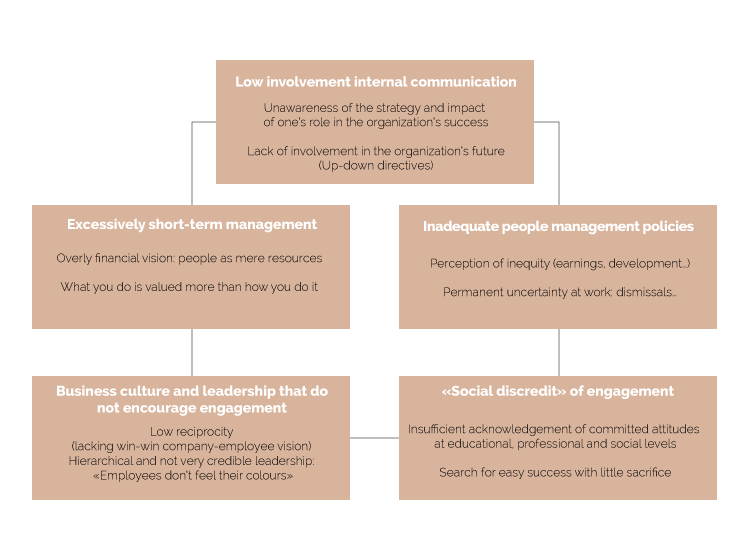
Source: David Reyero
Once the causes have been detected, we must deal with them using a firm and sustained strategy.
3. How to measure engagement?
There are numerous models and surveys evaluating engagement. In general, they tend to be analysed through both closed and open questions in order to allow greater freedom of feedback in the framework of the following variables: performance management, communication, change/innovation, diversity, leadership/development, recognition/compensation, direct supervisor, reconciliation, working within a team and overall level of effectiveness and engagement.
The Gallup Q12 study is the most widely used internationally and analyses the degree of employee engagement on the basis of 12 key elements:
• I know what is expected of me at work
• I have the materials and equipment I need to do my work right.
• At work, I have the opportunity to do what I do best every day.
• In the last seven days, I have received recognition or praise for doing good work.
• My supervisor, or someone at work, seems to care about me as a person.
• There is someone at work who encourages my development.
• At work, my opinions seem to count.
• The mission or purpose of my company makes me feel my job is important.
• My associates or fellow employees are committed to doing quality work.
• I have a best friend at work.
• In the last six months someone has talked to me about my progress.
• This last year, I have had opportunities at work to learn and grow.
But we should not limit ourselves to the above points. The key issue is not the quality of the results but rather what we are going to do with them.
4. How to improve engagement?
Within a VUCA environment, is it then possible to engage employees with our companies in the mid or long term? Is it worth making the “effort”? And what would we gain by it?
The evolution of socio-economics, education and personal values (especially with younger generations) and the current multi-generational management scenario makes it difficult for us, but it is both possible and desirable. We must find the “levers” to help us activate the machinery of engagement internally.
Fortunately, I have been able to implement several engagement management-based projects in companies from different sectors and have observed that there are a number of common elements in management which may facilitate the process.
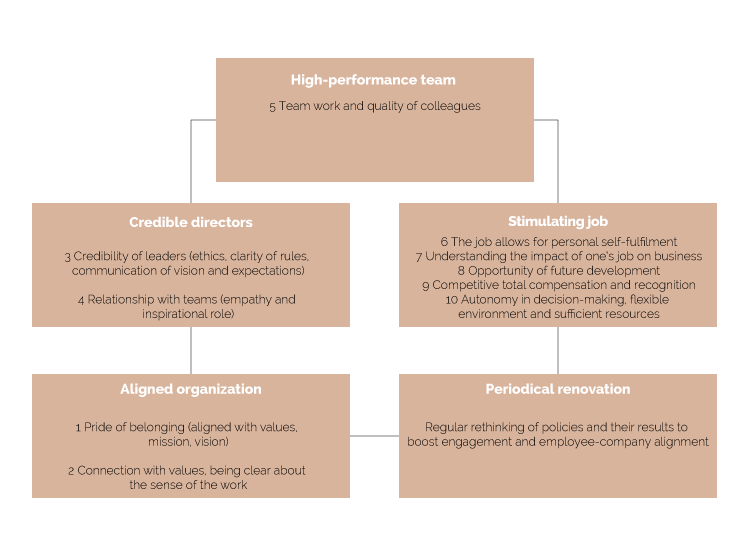
Source: David Reyero
5. What are the benefits of good engagement management?
The beneficial effects of engagement in business results should be observed from a dual perspective:
– business-based, with an improvement of several key ratios in any organization (internal and external reputation as an employer, productivity and the level of employees’ discretionary effort, sales, profits, quality of service to the client and share prices)
– person-based, with a greater alignment of employees with the business project and, consequently, a greater level of happiness at work and pride of belonging. The positive impacts are numerous: self-fulfilment at work, understanding the impact of one’s work on collective success, responsiveness to global corporate challenges, less stress and better health of workers, inter alia, as is shown in the following table:
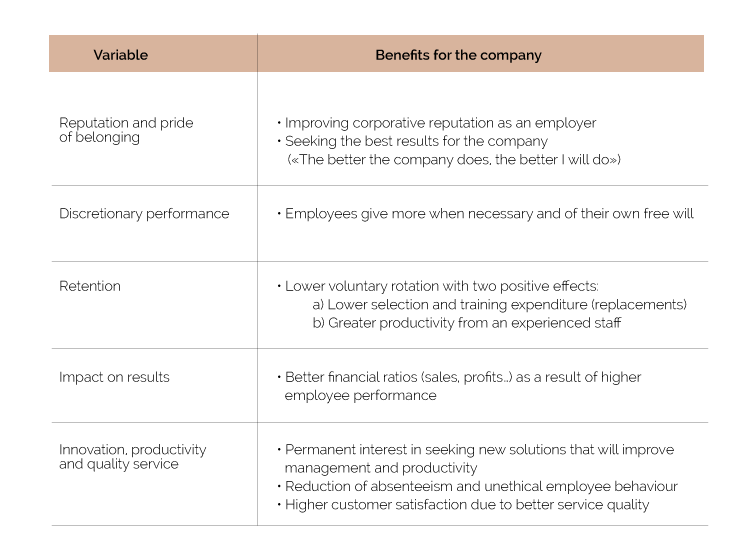
Source: David Reyero
In the management world it has been clearly demonstrated that increasing engagement improves an organization’s financial performance. Here are examples of international studies reflecting such a positive impact.

Sources: (1 y 2): Corporate Leadership Council. (3): Watson Wyatt. Study “The Value of Human Capital”
6 How to implement a plan to improve engagement?
As we have seen, the concept of engagement is highly complex and is influenced by numerous variables at four different levels (Organization, Manager, Team and Position). To illustrate such a multifactorial nature, suffice it to say that some studies have identified over 200 variables affecting engagement to a greater or lesser extent and it is, therefore, unrealistic to think we may improve them all at once.
To successfully implement a strategy that will boost an engagement-based culture, we must take into account three basic phases: analysis, impact, and change management. Let us then consider how we should act in each case.

Phase 1: Analysis: What challenges does engagement pose in an organization?
In this phase, we should analyse what the level of engagement is for each group of employees, reviewing the people management initiatives which do not work, the barriers to engagement (both visible and “invisible”) and the impact possible changes would have in the short, medium and long term.
To this end, it is essential to have a recurrent measurement process as proposed by Tatum in an interesting article entitled: “Measuring Engagement: the New Must in Human Resources” (http://ow.ly/UiGg8)
Phase 2: Focus / Impact: What objectives must be adopted to maximize results?
In this phase, we must define which policies are most effective for each group of employees and what the priority is in terms of resources and groups to be targeted. At this point, while strong engagement is desirable at all organizational levels, we must place special emphasis on the group of key employees in order to ensure organizational success.
Phase 3: Change management: What policies should be deployed or changed in order to achieve set objectives?
The implementation phase is the most critical, including aspects such as the management of sponsors and influencers, internal communication and internal work-groups (when suitable). The key factor in many cases is not speed, but rather consistency and support for the implementation. It is important to have the internal support required to ensure that employees positively appreciate changes and to generate a higher level of commitment to the company.
7. Which specific people management policies have greater impact on engagement?
In the table below I have synthesized a number of policies that may be deployed. They must be put into context and prioritized according to the needs of each company, organizational culture, the extent of required change and the detected strengths and weaknesses for engagement.
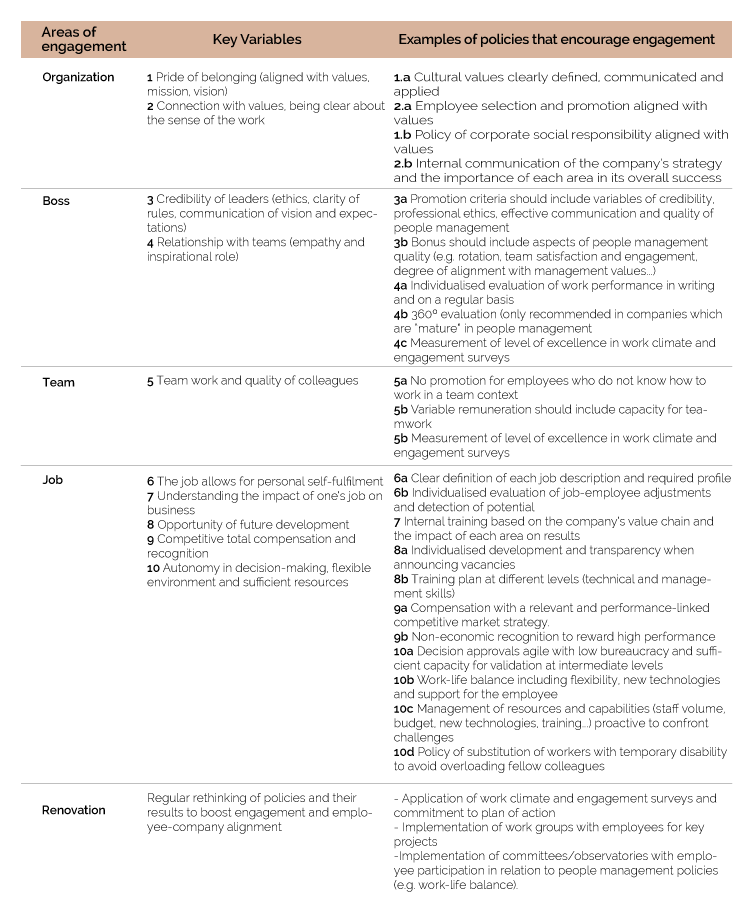
8. Conclusions: The decalogue of engagement as a differential factor in people management
1. In the context of employee engagement, we are faced with a worrying crisis rooted in cultural aspects of modern society and clearly improvable approaches to people management. Changes in the psychological contract brought about by new generations of employees who, in many cases, do not aspire to life-long jobs make it difficult to maintain a committed team of workers, both in terms of the present and future.
2. The interrelationship between the current economic crisis and the level of engagement has generated two negative effects: an overall reduction in commitment levels (due to greater uncertainty) and a lower level of discretionary performance by employees at all levels.
3. Engagement is a more powerful concept than mere satisfaction or motivation and is defined as a bidirectional employee-company bond (emotional, rational and transcendent), with a vision of mutual benefit, giving rise to the discretionary effort of employees and a strong desire to remain in the organization in the long term. In terms of the aforementioned factors, specialized studies show a consensus indicating that emotional and transcendent bonding is four times more powerful in generating engagement than their rational counterpart, which is more basic in nature and has less durable effects.
4. Engagement is beneficial for organizations as it improves discretionary effort (higher performance or “the extra mile”, as defined in Anglo-Saxon literature), retention (lower risk of voluntary rotation) and the “transcendent connection” of employees with the organization. By way of example and according to the Corporate Leadership Council each 10% of greater engagement generates a doubly positive effect: 6% more discretionary effort and 9% lower risk of rotation.
5. There are five key variables that must be taken into account with a view to properly managing engagement: an aligned organization, credible leaders, a cohesive high-performance team, a stimulating job and a philosophy of periodic renewal.
6. Trust in leaders and in the organizational culture is at the very basis of employee engagement as it creates a positive “breeding ground” conducive to the bidirectional employee-company bond. The synergies between trust and engagement generate, at least, two results: better places to work at and high-performance companies. There are three key factors that boost confidence: a stable and predictable character, a desire for the good of the other party and the existence of personal and professional skills that facilitate appropriate short and long-term results.
7. The role of senior and middle management is to support cultural changes through the definition of specific policies and coherence in their daily decisions (which in Anglo-Saxon culture is expressed as “walk the talk”). The impact of management is visualized in two aspects: a) there are major differences in the engagement levels in comparable companies on the basis of their specific management styles, and b) the greater engagement factor is the employee’s understanding of the impact of his or her work upon strategy, which goes to demonstrate the capital importance of a well-defined and executed internal communication (both at a global level and in the context of manager-employee interaction).
8. In parallel, down-up initiatives should be encouraged to involve more employees in the course set by organizations and to capture their ideas and opinions.
9. The specific policies that have most impact on engagement focus on aspects of transparency in the context of strategies and what is expected of each employee (giving sense to his or her work), coherence between values and daily decisions (in terms of both business decisions and people management), internal communication, performance compensation, professional development at all levels, policies facilitating the well-being of employees and a credible corporate social responsibility. With a sufficient level of confidence and engagement we should expect to have committed employees, showing company team-spirit, emotional maturity and optimism, high personal productivity, innovation and execution and an orientation towards change management.
10. According to numerous studies, the management of employee engagement is, together with comprehensive talent management, one of the main focal points of people management in leading companies, and has been accepted as a great competitive advantage, as it constitutes a business asset which, albeit increasingly scarce, is highly beneficial for organizations.
To build or strengthen a culture of engagement it is advisable to follow the following three stages:
a. Analysis: What are the engagement challenges in the organization?
b. Focus / Impact: What objectives must we set ourselves in order to maximize results?
c. Change management: What specific policies should be implemented or changed to achieve the set objectives?
And finally, the implementation or strengthening of an engagement culture has a great deal in common with change management. Therefore, to achieve such an objective, it is necessary to build upon a solid base: a clear strategy, honest communication, tenacity and effectiveness when addressing conflicts and resilience to obtain the necessary internal support that will generate the expected changes in attitude and behaviour. Ultimately, engagement has more to do with people and how they feel than anything else.
Although such transformation processes are usually rather complex and have impact in the medium term, it is well worth committing to them. A focus on improving employee engagement is an excellent opportunity to ensure happy and satisfied employees, customers and shareholders and will, in turn, improve the company’s reputation and turnover.
David Reyero Trapiello – Senior HR Business Partner – Sanofi Iberia
e-mail: David.reyero@sanofi.com / Twitter: @davidreyero73 / Linkedin: es.linkedin.com/in/reyerodavid

Leave a Reply